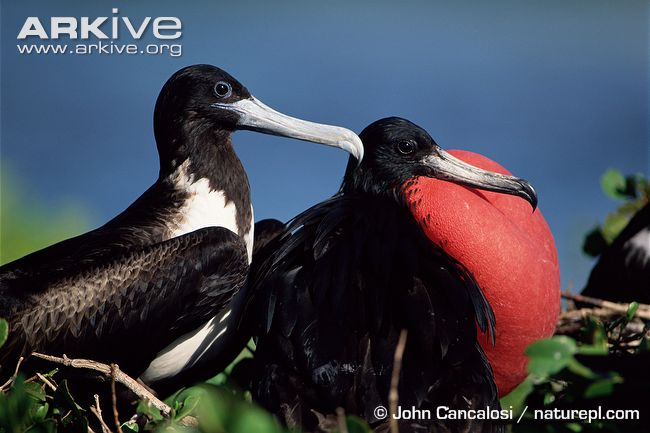Magnificent? Oh yes, they sure are! The great magnificent frigatebird!
From the left, we have the female and then the male magnificent frigatebird.
With just one look, you know how unique these birds are.
Well, don’t be too surprised yet because let me tell you, that they have more than just the looks. They are much more interesting than you’ll ever think!
The magnificent frigatebirds (Fregata magnificens), are a family of seabirds breeding along the Pacific coast of Costa Rica. The magnificent frigate birds’ body lengths are about 1 meter and they have extraordinarily long wings with wingspans ranging about 2 to 2.5 meters. The huge wingspans enable the magnificent frigatebirds to fly effortlessly as they glide through the air gracefully. Check this video out and you can see how beautiful and elegant they are as they glide through the air above the vast blue ocean.
In addition, some other unique characteristics about this bird that you probably have noticed from the picture above, is that the male magnificent frigatebird has an inflated red throat. This bright red balloon-like organ known as the gular sac, is not inflated at all times. The sac is only inflated to attract females during courtship. In fact, the male does more than just inflating its sac during this time.
Magnificent frigatebird chick in nest with male displaying to female
During the breeding season, the males would gather in groups and put up an amazing courtship display. While they are doing that, the females would be flying above them to choose who they want to mate with (Cramp and Simmons 1977).
Courtship in the world of the birds does not come with roses and diamond but a demonstration of their ‘Macho’ side. To attract the females, the males would inflate their bright red gular sacs as large as possible and expand their wings, waving them together with their head as if they were dancing. They also make unique bill-clattering sounds, much like tapping/vibrating noises.
Check this video out too for the courtship video of the magnificent frigatebird!
Another interesting point is that sometimes, the males would even try to burst the other males’ gular sacs to show their dominance to the females. Well, looks like the males are really trying very hard to impress the ladies!
Anyway, there are much more interesting facts about the magnificent frigatebird that you can find here! Have fun! (:
Literature Cited:
BBC Natural History Unit c/o BBC Motion Gallery. “Magnificent frigatebird males competing for nest site and displaying to females.” Video. arkive.org 2003. URL: http://www.arkive.org/magnificent-frigatebird/fregata-magnificens/video-09a.html (accessed on 6 April 2013).
Cancalosci, John. “Magnificent frigatebird male courting a female.” Photo. arkive.org 2003. URL: http://www.arkive.org/magnificent-frigatebird/fregata-magnificens/image-G57249.html (accessed on 6 April 2013).
Cramp, S. and K. E. L. Simmons. 1997. The birds of the Western Palearctic, Vol. 1: ostrich to ducks. Oxford Univ. Press, Oxford, U.K. URL: http://bna.birds.cornell.edu/bna/species/601/articles/behavior?searchterm=frigate (accessed on 6 April 2013).
Diamond, A. W., and E. A. Schreiber. 2002. Magnificent Frigatebird (Fregata magnificens). In The Birds of North America, No. 601 (A. Poole and F. Gill, eds.). The Birds of North America, Inc., Philadelphia, PA. URL: http://bna.birds.cornell.edu/bna/species/601/articles/behavior?searchterm=frigate (accessed on 6 April 2013).
Green Umbrella Ltd. “Magnificent frigatebird-overview” Video. arkive.org 2003. URL: http://www.arkive.org/magnificent-frigatebird/fregata-magnificens/video-00.html (accessed on 7 April 2013).
Osolinski, Stan. “Magnificent frigatebird chick in nest with male displaying to female.” Photo. arkive.org 2003. URL: http://www.arkive.org/magnificent-frigatebird/fregata-magnificens/image-G56392.html (accessed on 6 April 2013).
TRIVELPIECE, W. Z. and FERRARIS, J. D. (1987), Notes on the behavioural ecology of the Magnificent Frigatebird Fregata magnificens. Ibis, 129: 168–174. doi: 10.1111/j.1474-919X.1987.tb03198.x (accessed on 7 April 2013).


Quite amusing that the males will actually try to BURST one another’s sac! Is it all air inside, like a balloon?